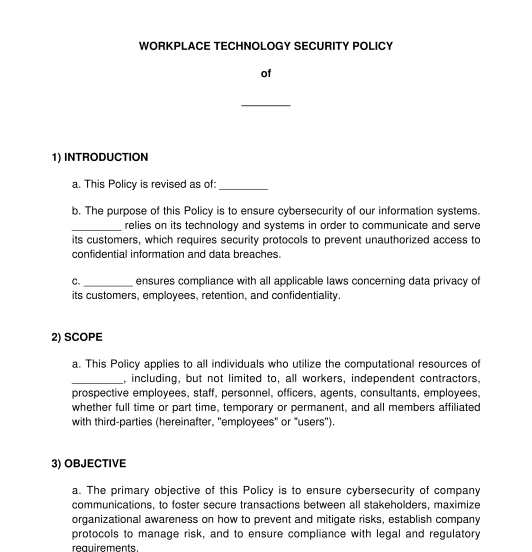 27/02/2025
27/02/2025

Answer a few questions and your document is created automatically.

Your document is ready! You will receive it in Word and PDF formats. You will be able to modify it.

 27/02/2025
27/02/2025
 Word and PDF
Word and PDF
 8 to 12 pages
8 to 12 pages
A Workplace Technology Security Policy provides employees of an organization with rules and best practices when using technology in the workplace to maintain cybersecurity. This document ensures the organization's cybersecurity and raises awareness on how all employees can make a difference by adhering to safety practices when using technology to prevent malware, viruses, trojans, and more.
The policy is important in the workplace because it helps create the parameters to protect company sensitive information, and it establishes clear responsibilities and boundaries related to technology use in the workplace.
No. Having a Workplace Technology Security Policy is not mandatory. However, with the increase in technological advancements, it's more necessary today than ever to plan and implement rules and best practices to maintain cybersecurity and avoid compromising systems and networks. Furthermore, having a policy in place ensures compliance with the law and may benefit the employer in the event of a dispute with an employee.
The document can be used if the organization wants to keep a policy that establishes what the workplace can and can't do with technology that connects to the organization's network.
Like this Workplace Technology Security Policy, there are many varying workplace policies, including as follows:
In contrast, the Workplace Technology Security Policy is used to address technology practices in the workplace, including the use of mobile devices, computers, and more. Each of these policies may be amended as laws evolve, or when the employer wants to make changes. Making changes is also important when new threats and vulnerabilities arise.
A workplace technology security policy should, at a minimum, contain:
Each of these subsections work together to help safeguard the company by making security a priority and reducing risk.
There is no set duration of an employment policy as they normally subsist for the duration of the lifetime of the employer's organization. In other words, the duration is indefinite. However, policies must be amended to reflect the changes in legislation and should be refined to adapt to industry standards. Companies may wish to review this policy on an annual basis to ensure utmost security.
Employers should include this Policy in a new employee's welcome package to ensure they are familiar with workplace protocol and avoid any future doubt that they were unaware of a specific rule or company policy. When significant changes arise in the Policy, the employer should provide a copy of the new Policy to all staff in a timely manner.
Employees should also sign the acknowledgement at the end of the document confirming they read and understand the Workplace Technology Security Policy. The employer should then add a copy of the signed Policy to each employee's file. The signature may be obtained electronically.
To properly implement the policy, the company should conduct a cybersecurity awareness program to help all employees understand the risks of cybersecurity attacks, including the potential for severe financial losses and vulnerability. As part of the program, the company may also address the short-term and long-term impacts of cybersecurity attacks, and how employees can make a difference and what to do best to avoid compromising company systems and networks. The company should also ensure that all software is regularly updated, employee-use of company systems is appropriately monitored, and have multi-factor authentication in place.
The Canadian Criminal Code outlines cybercrime laws. For example, it is a criminal offence to conduct hacking (use, control, intercept computer systems). This Policy ensures compliance with Canadian laws and regulations. Furthermore, employment policies must be consistent with employment law. The following pieces of legislation govern employment law:
Additionally, Canada's Anti-Spam Legislation also applies, which governs spam messaging, including emails, text messages, and more.
You fill out a form. The document is created before your eyes as you respond to the questions.
At the end, you receive it in Word and PDF formats. You can modify it and reuse it.
Workplace Technology Security Policy - Sample, template
Country: Canada (English)